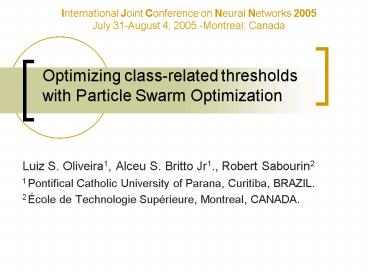Optimizing classrelated thresholds with Particle Swarm Optimization - PowerPoint PPT Presentation
1 / 17
Title:
Optimizing classrelated thresholds with Particle Swarm Optimization
Description:
Optimizing class-related thresholds ... 1 Pontifical Catholic University of Parana, Curitiba, BRAZIL. 2 cole de Technologie Sup rieure, Montreal, CANADA. ... – PowerPoint PPT presentation
Number of Views:130
Avg rating:3.0/5.0
Title: Optimizing classrelated thresholds with Particle Swarm Optimization
1
Optimizing class-related thresholdswith Particle
Swarm Optimization
International Joint Conference on Neural Networks
2005 July 31-August 4, 2005 -Montreal, Canada
- Luiz S. Oliveira1, Alceu S. Britto Jr1., Robert
Sabourin2 - 1 Pontifical Catholic University of Parana,
Curitiba, BRAZIL. - 2 École de Technologie Supérieure, Montreal,
CANADA.
2
Introduction
- Cascading classifiers have been quite used to
solve pattern recognition problems - Improvement of classification.
- Reduction of the complexity.
- The majority of patterns can be explained by a
simple rule - Well behaved patterns.
3
Introduction
- Easy cases
- They can be classified using a relatively small
portion of the features available. - Difficult cases
- They use more sophisticated classifiers,
therefore more expensive. - More features or complex classifiers.
4
Cascading Classifier
Inputs rejected by the first stage are handled
by the next ones
Reject-option
5
Reject-option
- The most used error-reject trade-off was given by
Chow (1970)
Rejected
Accepted
6
Reject-option
- Chows rules provides the optimal error-reject
trade-off only if the posteriori probabilities
are known. - Which does not happen in most of cases.
- Affected by significant estimate errors.
- Multiple reject thresholds for the different data
classes Fumera et al
7
Reject-option with multiple thresholds.
Rejected
- It has been demonstrated that the values of
thresholds T1Tn exist that the corresponding
accuracy A(T1Tn) is equal or higher than A(T)
Accepted
8
Optimization problem
- Find N thresholds that maximize the accuracy for
a fixed error rate. - It can be formulated in terms of constrained
maximization problem as follows - PSO to solve this problem
- Better results than those achieved by Fumera et
al.
9
A Cascading System
- Generated through a feature selection algorithm
IWFHR04. - Base classifier
- MLP, trained with 132 features extracted from
concavities and contour. - Handwritten digits (10 classes)
- NIST SD19
- 195k, 28k, and 30k for training, validation, and
testing. - 99.13 on test set at zero-rejection level.
10
A Cascading System
- Feature selection method generated five
classifiers
Base 132 99.13
11
Performance
- Using Fumeras algorithm to define the
thresholds. Error fixed at 0.5
78 of the patterns are classified in the
first level of the cascade
12
Performance
- The computation effort can be measured in terms
of the number of feature-values - where n is the number of classifiers, mi is the
number of features used by the classifier i and
xi is the number of instances classified by the
classifier i
13
Performance
- By computing TVF, we observe that the cascade can
reduce this index in about 75 compared to the
base classifier. - Performance at the same level
- 99.38 vs 99.13
14
Searching thresholds with PSO
- Conventional PSO using the sociometric principle
gbest - Maximum velocity constraint.
- 10-Dimensional space.
- Values ranging from 0 to 1
- Size of the swarm 20.
- c1 and c2 2
- The inertia weight w was set to 0.9 and decreased
over the iterations to allow exploitation.
15
Performance using PSO
- For an error rate fixed at 0.5
With PSO, 82 of the patterns were classified in
the first level of the cascade
16
Conclusions
- Cascading classifier system is a very interesting
approach to reduce complexity. - It can perform even better when the reject option
is properly fine-tuned. - We have demonstrated trhough experimentation that
PSO is an efficient approach to deal with this
kind of problem.
17
Future Works
- Using PSO to make a deeper optimization,
addressing parameters such as - The number of the classifiers in the cascade.
- A reject option in the base classifier.































